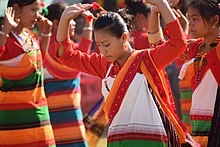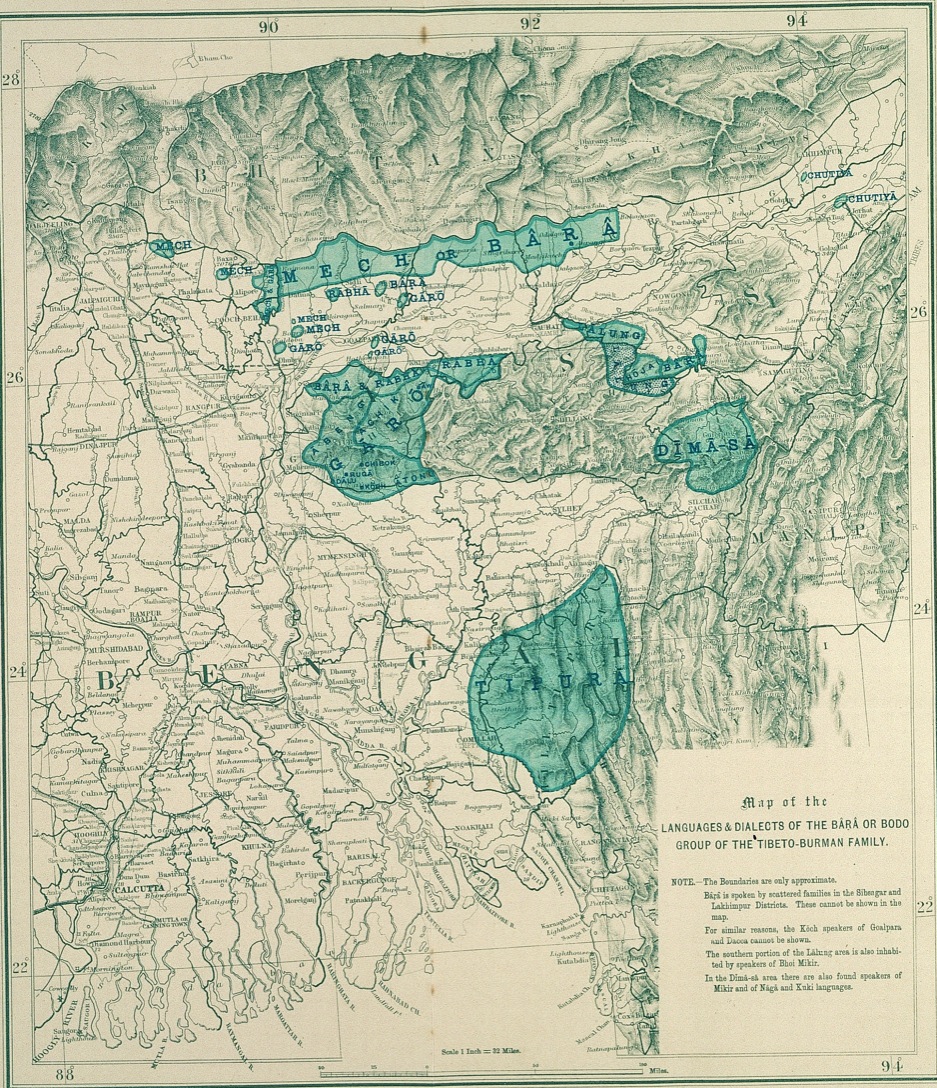Dimasa people
This article needs additional citations for verification. (October 2020) |
This article is written like a personal reflection, personal essay, or argumentative essay that states a Wikipedia editor's personal feelings or presents an original argument about a topic. (September 2020) |
Dimasa | |
|---|---|
 Barman Dimasa girl while performing Baidima, the traditional dance of Dimasa. | |
| Total population | |
| 262,413 (2011 Census) | |
| Regions with significant populations | |
| 142,961 (2011, Dimasa-Kachari,in hill districts of Assam only)[1] | |
| Languages | |
| Dimasa | |
| Religion | |
| Hinduism[2] | |
| Related ethnic groups | |
| Other Bodo–Kachari peoples | |
| Part of a series on the |
| Culture of Assam |
|---|
 |
The Dimasa people (local pronunciation:
Ancient Dimasa tradition maintains that sixty thousand (60,000) Moon months (Lunar months) ago, they left their ancestral land when it suffered a severe
The Dimasa
The Dimasas form a "sealed" society—every member drawing his or her patriarchal lineage from one of the forty two male clans (sengphong—"holder of the sword") and the matriarchal lineage from one of the forty-two female clans (jalik or julu).
It stands for Di-ma-sa meaning sons of big waters
Clans
Dimasa men are divided into 40 patriarchal clans. These are:[12][13]
- Ardaosa
- Mitherpangsa
- Diphusa
- Hagjersa
- Thaosensa
- Phonglosa
- Sengyungsa
- Raijungsa
- Bader-Baiga
- Daulagajao
- Daolagupu
- Hojaisa
- Kemprai
- Jidungsa
- Baindosa (Nunisa)
- Khersa
- Hasnu
- Haflongbar
- Bodosa/Bathari
- Hapila
- Diruwasa
- Naidingsa
- Daodunglangtha
- Karigapsa
- Joraisa
- Hasamsa
- Nabensa
- Dibragede
- Langthasa
- Girisa
- Porbosa
- Maibangsa
- Johorisa
- Sorongpang
- Gorlosa
- Hakmaosa
- Maramsa
- Jarambusa
- Labtaisa
- Laobangdisa
Distribution


History
This section needs expansion. You can help by adding to it. (June 2024) |
Religion
This section needs additional citations for verification. (September 2020) |
According to the 2011 Census of India, more than 99% of all Dimasa living in
Society
The traditional village headman, who is at the top of the village administration, is a Khunang. He has both executive and judiciary powers. He is assisted by another official called the Dillik (Assistant Headman). Next to him is Daulathu who occupies the third place. Next to the Daulathu is the Haphaisgao, who holds office for two years. Other village officials include Phrai, Montri, Hangsbukhu, and Jalairao.[16]
Festivals
Since 1994 as per the decision of Dimasa community of Dima Hasao, the Autonomous Council of Dima Hasao had officially declared 27 January as Busu Dima festival day.[17]
Dress and ornaments
Ornaments
The male Dimasa use only two types of ornaments namely Yaocher and Kharik.
Females use:[18]
- Phowal: necklace made of expensive Coral and Real silver metal beads; also worn by males
- Jongsama: necklace made of micro-beads of any colour, with coral and silver beads in between.
- Rangbarsha: necklace made of coins.
- Chandrawal: necklace made of three silver chains with flower shapes.
- Rmailik: necklace made of micro-beads; the colour pattern is same with the Rijamphain beren or Rmai (chest wrapper)
- Likjao: necklace made of Red micro beads
- Likshim: necklace made of black micro beads
- Khadu: heavy silver bangle
- Khamaothai: silver or gold earring
- Yaoshidam: finger ring[19]
Dances
The dance forms of the Dimasa Kachari are complex in character.[20]
Any Dimasa dance is called Baidima ( Bai-means dance, Dima-means Dimasa).[21]
See also
Notes
- ^ "ST-14 Scheduled Tribe Population By Religious Community - Assam". census.gov.in. Retrieved 29 February 2020.
- ^ "Census of India Website : Office of the Registrar General & Census Commissioner, India". www.censusindia.gov.in. Retrieved 2 November 2017.
- ^ "639 Identifier Documentation: aho – ISO 639-3". SIL International (formerly known as the Summer Institute of Linguistics). SIL International. Retrieved 29 June 2019.
Ahom [aho]
- ^ "Population by Religious Communities". Census India – 2001. Ministry of Home Affairs, Government of India. Retrieved 1 July 2019.
Census Data Finder/C Series/Population by Religious Communities
- ^ "Population by religion community – 2011". Census of India, 2011. The Registrar General & Census Commissioner, India. Archived from the original on 25 August 2015.
2011census/C-01/DDW00C-01 MDDS.XLS
- ^ "Another local kingdom ... was that of the Dimasas in the north Cachar hills. They were known to the Ahoms as Timisa, clearly a corruption of Dimasa..." (Shin 2020:61)
- ^ (Ramirez 2007:94)
- ^ " Culturally speaking, present-day Cachar Dimasa can hardly be distinguished from the Bengali majority and they seem to make little attempt politically to assert their identity. In the hills, however, Dimasa remained demographically dominant whilst cohabiting with Hmar-Kukis and Zemi Nagas." (Ramirez 2007:93)
- S2CID 229455719, retrieved 25 November 2021
- ^ (Ramirez 2007:2007)
- ^ (Ramirez 2007:93)
- ^ Surnames, Dimasa (25 April 2021). "Dimasa language surnames | Dimasa surnames list or last name". Archived from the original on 21 December 2020. Retrieved 25 April 2021.
- ^ Monograph Series, Census of India (1961). Dimasa Kacharis of Assam (PDF). New Delhi: Government of India.
- ^ "ST-14 Scheduled Tribe Population By Religious Community - Assam". census.gov.in. Retrieved 7 February 2020.
- Census of India 2001
- S2CID 134950348.
- ISBN 9789004263925, retrieved 25 November 2021
- ^ "Facebook". www.facebook.com. Retrieved 25 April 2021.
- ISSN 0276-8739.
- ^ Dance, Baidima. "Baidima Dance | Dimasa Traditional Dance | Baidima Folk Dance of Assam - Traditional Folk Dances of India". Archived from the original on 25 April 2021. Retrieved 25 April 2021.
- S2CID 234010733.
References
- Annexure - Ib: List of Notified Scheduled Tribes (PDF) (Report). Census of India. 2011. Retrieved 30 June 2019.
- Jacquesson, François (2008). "Discovering Boro-Garo" (PDF). History of an Analytical and Descriptive Linguistic Category.
- Bareh, H. Gazetteer of India
- Barman, N. K. Queen of Cachar of Herambo and the History of the Kachchhari
- Barpujari, S. K. (ed) (1997) History of the Dimasas: from the earliest times to 1896 AD, Haflong: Autonomous Council, N.C. Hills District (Assam) .
- Bathari, Uttam (2014). Memory History and polity a study of dimasa identity in colonial past and post colonial present (PhD). Gauhati University. hdl:10603/115353.
- Bhattacharjee, J. B. (1992), "The Kachari (Dimasa) state formation", in Barpujari, H. K. (ed.), The Comprehensive History of Assam, vol. 2, Guwahati: Assam Publication Board, pp. 391–397
- Bordoloi, B. N. (1988) The Dimasa Kachari, Tribal Research Institute of Assam, Guwahati.
- Danda, D. (1989) The Dimasa Kacharis of Assam, Concept Publishing co. New Delhi.
- Gait, Edward A. (1906) A History of Assam, Calcutta 1906.
- Rhodes, N. G. and Bose, S. K. (2006) A History of the Dimasa Kacharis - As Seen through Coinage New Delhi : Mira Basu Publishers.
- Roy, Babul (1998) "Socio-Cultural and Environmental Dimensions of Tribal Health: A Study among the Dimasa Kacharis and the Zeme Nagas of N. C. Hills in Assam" Ph. D. Thesis (Unpublished), Gauhati University, Guwahati, Assam (India).
- Roy, Babul (2000) "Medical Pluralism and Pattern of Acceptance of Medicine among the Dimasa Kacharis of Assam" The Journal of Human Ecology. Kamal-Raj Pub., Delhi.
- Roy, Babul (2002) "Descent groupings, belief system and social structure among the Dimasa Kacharies of Assam", Man in India, Vol.82,No.1&2.
- Ramirez, Ramirez (2007), "Politico-ritual variations on the Assamese fringes: Do social systems exist?", in Sadan, Mandy; Robinne., François (eds.), Social Dynamics in the Highlands of Southeast Asia Reconsidering Political Systems of Highland Burma, Boston: Brill, pp. 91–107
- Shin, Jae-Eun (2020). "Descending from demons, ascending to kshatriyas: Genealogical claims and political process in pre-modern Northeast India, The Chutiyas and the Dimasas". The Indian Economic and Social History Review. 57 (1): 49–75. S2CID 213213265.


